Eta Carinae (η Car) is a massive binary star system located approximately 7,500 light-years away in the constellation Carina. Composed of at least two exceptionally massive stars, the system is shrouded in the Homunculus Nebula, a bipolar emission and reflection nebula located within the larger Carina Nebula. The primary component of the Eta Carinae system is one of the most massive stars known in the Milky Way.
Eta Carinae has an apparent magnitude that has been observed to vary from magnitude -1.0 to 7.6. In 1837, it famously brightened to magnitude -1.0 during an outburst episode known as the Great Eruption. For three days, Eta Carinae was the second brightest star in the sky, after Sirius. In recent years, it has shone at magnitude 4.3 to 4.8. The star system is a member of Trumpler 16, a massive young open star cluster that contains some of the Milky Way’s most luminous known stars.
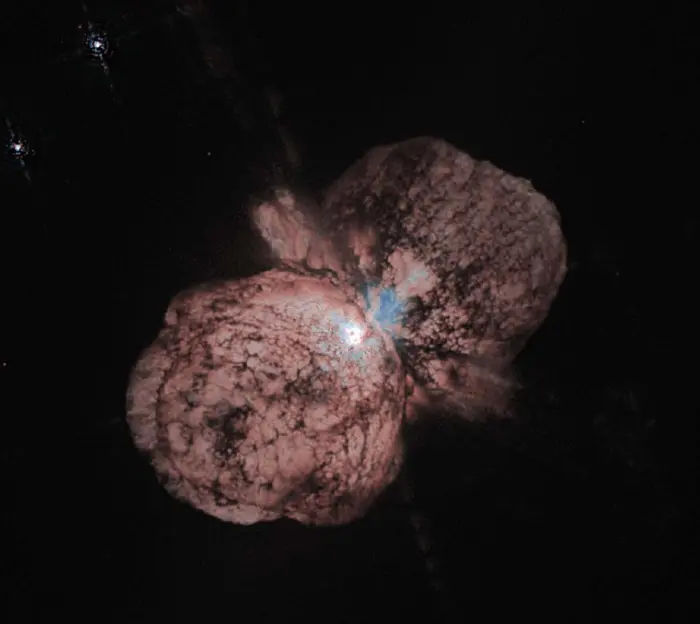
A huge, billowing pair of gas and dust clouds are captured in this stunning NASA Hubble Space Telescope image of the supermassive star Eta Carinae. Eta Carinae was observed by Hubble in September 1995 with the Wide Field Planetary Camera 2 (WFPC2). Images taken through red and near-ultraviolet filters were subsequently combined to produce the color image shown. A sequence of eight exposures was necessary to cover the object’s huge dynamic range: the outer ejecta blobs are 100,000 times fainter than the brilliant central star. Eta Carinae was the site of a giant outburst about 150 years ago, when it became one of the brightest stars in the southern sky. Though the star released as much visible light as a supernova event, it survived the outburst. Somehow, the event produced two polar lobes and a large thin equatorial disk, all moving outward at about 1.5 million miles per hour. Hubble observations show that excess violet light escapes along the equatorial plane between the bipolar lobes. Apparently there is relatively little dusty debris between the lobes down by the star; most of the blue light is able to escape. The lobes, on the other hand, contain large amounts of dust which preferentially absorb blue light, causing the lobes to appear reddish. Image credit: Jon Morse (University of Colorado) & NASA Hubble Space Telescope
Star system
The Eta Carinae star system is composed of Eta Carinae A, a luminous blue variable, and Eta Carinae B, a massive O-type star that is believed to be a giant or supergiant (or possibly even a Wolf-Rayet star). The primary component is one of the most massive and most luminous stars known. The companion star is also exceptionally massive. Both components are supernova candidates.
Eta Carinae A is believed to have a mass between 100 and 120 solar masses and Eta Carinae B, between 30 and 60 solar masses. The combined mass of the system may have been over 250 solar masses before the Great Eruption.
The two components orbit each other with a period of 2,022.7 ± 1.3 days (5.539 years). The system has a semi-major axis of 15.4 astronomical units and an eccentricity of 0.9. This corresponds to a physical distance that varies from around 1.6 astronomical units to 30 astronomical units, comparable to the distances between the Sun and Mars and the Sun and Neptune.
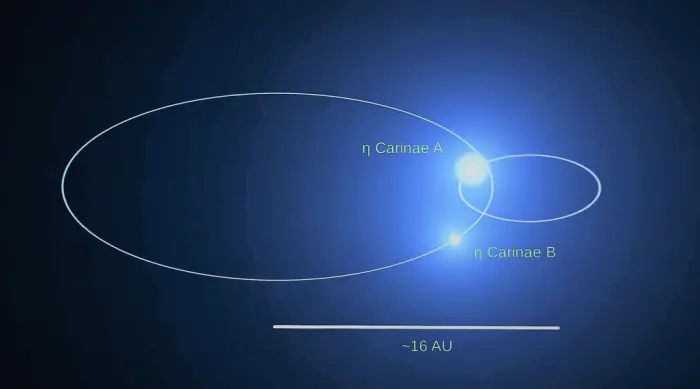
Orbit of the Eta Carinae binary star system. Image based on the NASA Goddard video at https://svs.gsfc.nasa.gov/cgi-bin/details.cgi?aid=11725. Credit: NASA’s Goddard Space Flight Center, Wikimedia Commons/Lithopsian (CC BY-SA 4.0 DEED)
The orbital period of the Eta Carinae system has changed over time because of mass loss and accretion. It was 5.52 years between the Great Eruption in 1837 and the eruption in 1890, and may have been between 4.8 and 5.4 years before the Great Eruption.
The orbital cycle causes significant changes in the system’s spectrum when the components are closest to each other. These changes are referred to as spectroscopic events. It is these events that allowed astronomers to derive the system’s orbital elements.
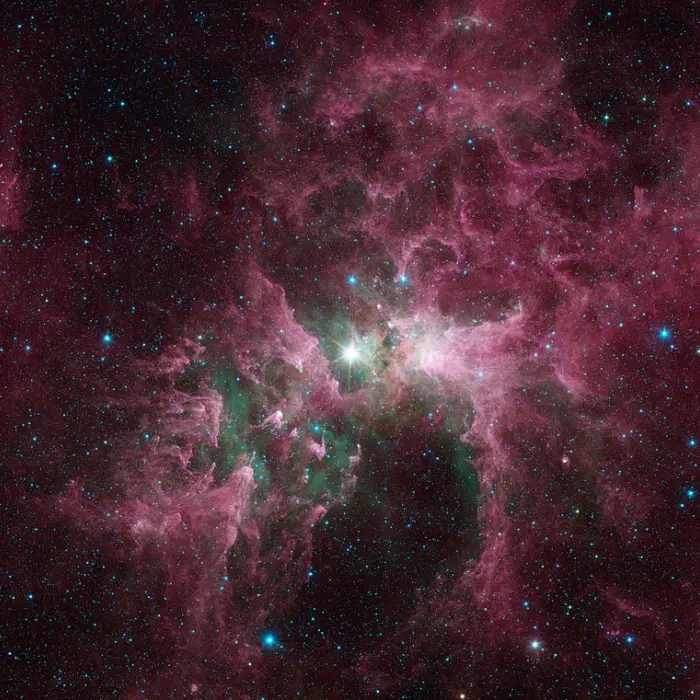
Massive stars can wreak havoc on their surroundings, as can be seen in this new view of the Carina Nebula from NASA’s Spitzer Space Telescope. The bright star at the center of the nebula is Eta Carinae, one of the most massive stars in the galaxy. Its blinding glare is sculpting and destroying the surrounding nebula. Eta Carinae is a true giant of a star. It is around 100 times the mass of our sun and is burning its nuclear fuel so quickly that it is at least one million times brighter than the sun. It has brightened and faded over the years, and some astronomers think it could go out as a supernova in the not-too-distant future. Such a tremendous outflow of energy comes at a great cost to the surrounding nebula. The infrared light from the star destroys particles of dust, sculpting cavities and leaving pillars of denser material that point back to the star. Spitzer’s infrared vision lets us see the dust, shown in red, as well as clouds of hot, glowing gas that appear green. Spitzer released an image of a small part of this nebula in 2005. Subsequent observations greatly expanded our view of the entire region, and the data were combined and reprocessed as part of the extended Galactic Legacy Infrared Mid-Plane Survey Extraordinaire (GLIMPSE) project. Image credit: NASA/JPL-Caltech
The binarity of Eta Carinae was confirmed in 1997 and 1998, based on spectroscopic data and X-ray observations of the system during the periastron passage (the closest approach of the components during their orbit).
The brightness of the system has been observed to vary between magnitude -1.0 to magnitude 7.6. In 2011, Eta Carinae shone at magnitude 4.8. In 2013, it slightly brightened to magnitude 4.6 and, in 2018, it had an apparent magnitude of 4.3.
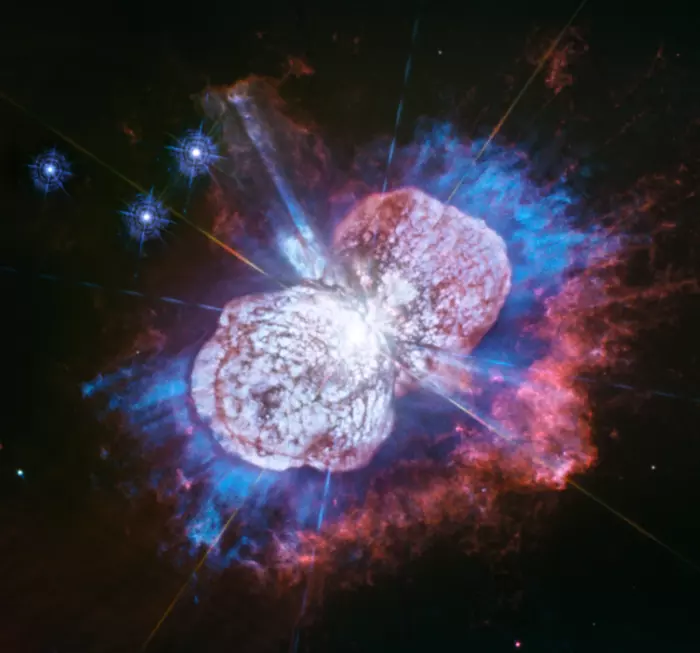
Telescopes, including Hubble, have monitored the Eta Carinae star system for more than two decades. It has been prone to dramatic outbursts, including an episode in the 1840s during which ejected material formed the bipolar bubbles seen here. Now, using Hubble’s Wide Field Camera 3 to probe the nebula in ultraviolet light, astronomers have uncovered the glow of magnesium embedded in warm gas (shown in blue) in places they had not seen it before. The luminous magnesium resides in the space between the dusty bipolar bubbles and the outer shock-heated nitrogen-rich filaments (shown in red). The streaks visible in the blue region outside the lower-left lobe are a striking feature of the image. These streaks are created when the star’s light rays poke through the dust clumps scattered along the bubble’s surface. Wherever the ultraviolet light strikes the dense dust, it leaves a long, thin shadow that extends beyond the lobe into the surrounding gas. Image credit: NASA, ESA, N. Smith (University of Arizona, Tucson), and J. Morse (BoldlyGo Institute, New York) (CC BY 4.0 DEED)
Eta Carinae A
The primary component is a luminous blue variable with a mass of about 100 solar masses and a radius of about 240 solar radii. The star’s radius is difficult to define because the star is surrounded by an optically dense stellar wind. The radius is about 60 solar radii at optical depth 155, below the wind, and 881 solar radii at optical depth 2/3, near the top of the wind.
Eta Carinae A shines with 4.6 million solar luminosities. Other estimates of the star’s luminosity are in the range between 2.96 million and 4.1 million times that of the Sun. The hot blue star has an estimated temperature between 9,400 K and 35,200 K. It is believed to be less than 3 million years old.
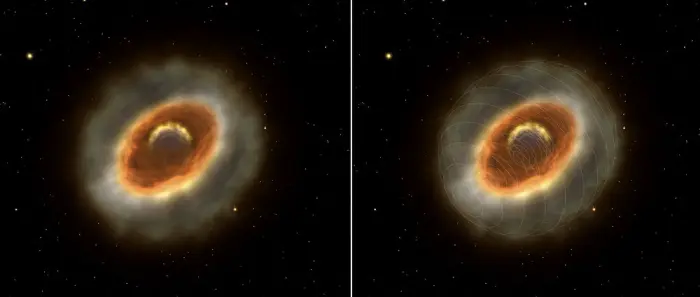
The stellar wind regions of Eta Carinae. The artist’s impression visualizes the inner regions of Eta Carinae probed with AMBER at different wavelengths for the first time. The figure shows the inner elongated stellar wind region observed in continuum light and the more extended region of the Brackett Gamma line emission. The sizes of both zones are 4 and 10 milli-arcseconds (corresponding to 10 and 22 Astronomical Units). The dense stellar wind totally obscures the central star. Image credit: ESO (CC BY 4.0 DEED)
Eta Carinae A had an initial mass between 150 and 250 solar masses and has already shed at least 30 solar masses of material. The star has one of the highest mass loss rates known. It is currently losing around 10-3 solar masses a year. During the Great Eruption, it lost at least 10-20 solar masses. The companion may have accreted several solar masses of ejected material during the event. The primary component is the only star observed to produce an ultraviolet astrophysical laser.
Luminous blue variables are massive unstable supergiant stars that exhibit a range of spectroscopic and photometric variations, including periodic outbursts and, more rarely, larger eruptions. They show irregular changes in temperature at roughly constant luminosity. The least luminous of these stars have temperatures of around 10,000 K and a luminosity of 250,000 Suns in their quiescent state. During outbursts, their temperatures drop to around 8,000-8,500 K. Eta Carinae was much cooler (5,000 K) during the Great Eruption.
Other examples of this class include the class prototype S Doradus in the Large Magellanic Cloud in the constellation Dorado, AG Carinae and HR Carinae in Carina, P Cygni in Cygnus, and V4029 Sagittarii in Sagittarius. The Pistol Star and the Peony Star in Sagittarius are also candidate LBVs. Eta Carinae is the most luminous LBV in the Milky Way.
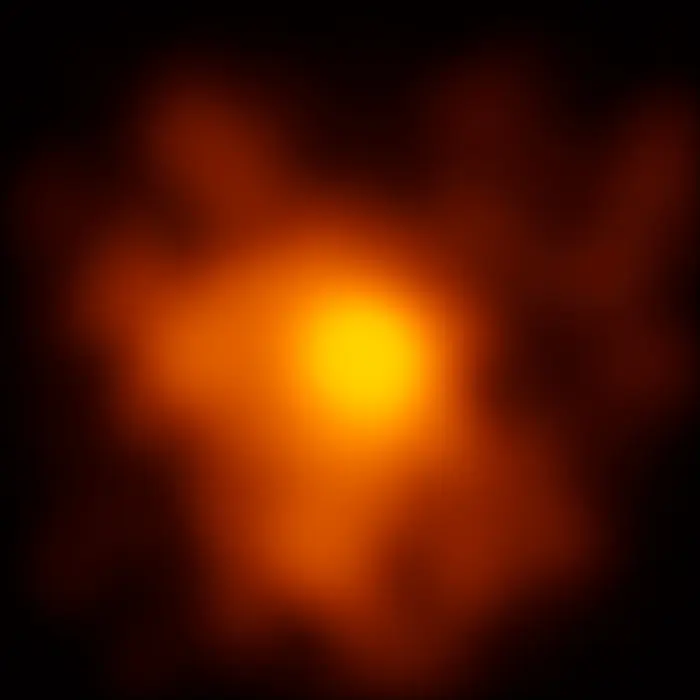
This image represents the best image of the Eta Carinae star system ever made. The observations were made with the Very Large Telescope Interferometer and could lead to a better understanding of the evolution of very massive stars. Image credit: European Southern Observatory (CC BY-SA 4.0 DEED)
Eta Carinae B
Eta Carinae B is believed to be an O-type star with between 30 and 80 times the Sun’s mass and a radius between 14.3 and 23.6 solar radii. With a surface temperature of 37,200 K, it is less than a million times more luminous than the Sun. Like its companion, it has an estimated age of up to 3 million years. The star is believed to be a supergiant or giant, but may also be a Wolf-Rayet star.
Brightness
Eta Carinae is one of the best-known variable stars in the sky. It was briefly one of the brightest stars in the sky during the Great Eruption in 1837. At other times, it was invisible to the unaided eye. In recent decades, its apparent magnitude has varied between 4.3 and 4.8.
English naturalist and explorer William John Burchell was the first to identify Eta Carinae as a variable star in 1827. Burchell noted that the star reached the first magnitude and was about as bright as Acrux (Alpha Crucis) in the Southern Cross, the 13th brightest star in sky.
Following the outburst, Eta Carinae faded to second magnitude for a decade. English astronomer John Herschel noted that it shone at magnitude 1.4 until November 1837. In 1837, the star reached its peak brightness during an episode known as the Great Eruption.
When it was first recorded in the 17th century, Eta Carinae was a fourth-magnitude star. After brightening to first magnitude in the mid-19th century, it became invisible again. Between 1900 and 1940 it shone at magnitude 7.6, well below unaided eye visibility.
In the second half of the 20th century, the star became visible again. In 1953, it brightened to magnitude 6.5 – the border of visibility – and gradually kept getting brighter.
A study published in 1996 was the first to pinpoint a period of 5.52 years for the brightness variations. The period was later determined to be 5.54 years. The deep minimum is thought to be produced by the occultation of the X-ray emitting gas by the thick inner wind of the primary component.
In 1998 and 1999, Eta Carinae suddenly doubled in brightness. In 2014, it was brighter than magnitude 4.5.
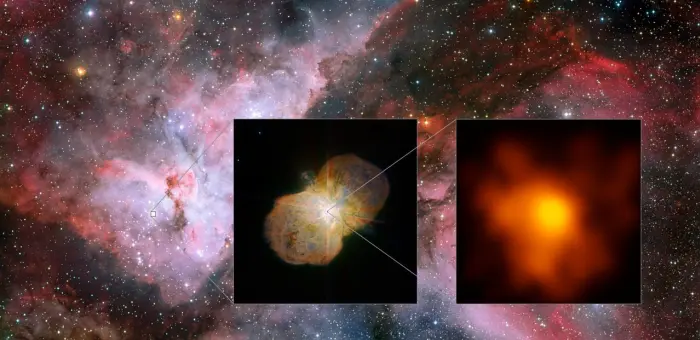
This mosaic shows the Carina Nebula (left part of the image), home of the Eta Carinae star system. This part was observed with the Wide Field Imager on the MPG/ESO 2.2-metre telescope at ESO’s La Silla Observatory. The middle part shows the direct surrounding of the star system: the Homunculus Nebula, created by the ejected material from the Eta Carinae system. This image was taken with the NACO near-infrared adaptive optics instrument on ESO’s Very Large Telescope. The right image shows the innermost part of the system as seen with the Very Large Telescope Interferometer (VLTI). It is the highest resolution image of Eta Carinae ever. Image credit: ESO/G. Weigelt (CC BY 4.0 DEED)
Great Eruption
On December 16, 1837, Eta Carinae dramatically brightened, outshining Rigel, the seventh brightest star in the sky. The sudden brightening was the beginning of the Great Eruption, an outburst event that lasted for about 18 years. On January 2, 1838, the star equalled Alpha Centauri, the third brightest star in the sky, only to slightly fade for a period of about three months. At peak brightness, Eta Carinae had a luminosity 50 million times that of the Sun. It was the brightest star in our galaxy and released energy comparable to that of a supernova.
From March 11 to 14, 1843, it was reported to be brighter than Canopus, the second brightest star, only to slightly fade again. It likely reached magnitude -0.8 at the time. By late March, it was fainter than Canopus but still brighter than Alpha Centauri, and then faded again.
The star shone around magnitude 0.2 for most of 1844 and brightened again at the end of the year. In 1845, it reached a peak brightness of -1. For the next decade, from 1845 to 1856, it gradually faded by about 0.1 magnitudes per year.
Light echoes from the Great Eruption, detected in other parts of the Carina Nebula, were observed with the U.S. National Optical Astronomy Observatory’s Blanco 4-meter telescope at the Cerro Tololo Inter-American Observatory. Analysis of the spectra indicated that at the time the light was emitted, Eta Carinae appeared as a yellow supergiant of the spectral type G2-G5 with a surface temperature of 5,000 K. The temperature was about 2,000 K lower than expected from a supernova impostor event.
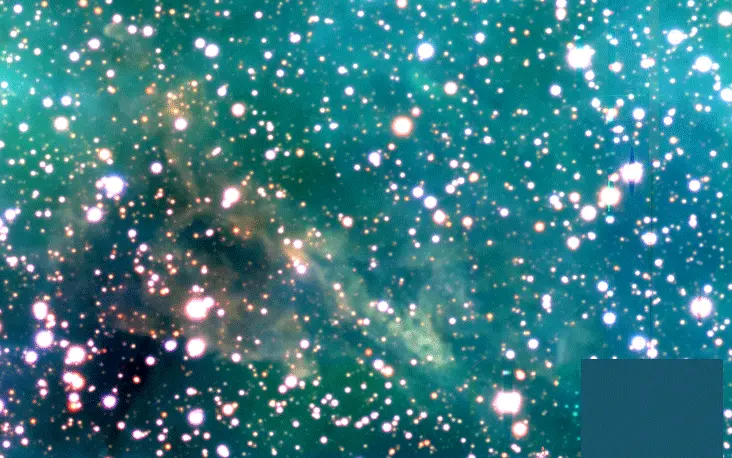
One of the light echoes caused by the Eta Carinae eruption, captured by the Dark Energy Camera (DECam) mounted on the Victor M. Blanco 4-meter Telescope at the Cerro Tololo Inter-American Observatory (CTIO) in the Chilean Andes. Image credit: NSF, AURA, NOAO; image processing: Melina Thévenot (CC BY-SA 4.0 DEED)
The peaks observed in 1827, 1838 and 1843 are believed to have coincided with the point in Eta Carinae’s orbit at which the two binary components were closest together (periastron). Mass transfer from the companion is one of the possible explanations for the outbursts.
In 1857, Eta Carinae started to rapidly decrease in brightness and became invisible to the unaided eye by 1886. The fading is attributed to the condensation of dust in the material expelled from the star during the Great Eruption. The star’s intrinsic luminosity is not believed to have caused the fading. The ejected material forms the Homunculus Nebula, which heavily obscures the Eta Carinae star system.
Eta Carinae experienced a smaller eruption in 1892, reaching 6th magnitude, and then faded again. It had started to brighten in 1887 and reached a peak magnitude of 6.2 in 1892. By March 1895, it faded to magnitude 7.5.
A 2015 study proposed that the giant eruption may have been caused by a merger in a triple star system. Dutch astronomers Simon Portegies Zwart (the Leiden Observatory) and Edward P.J. van den Heuvel (the University of Amsterdam) used computer simulations with the Astrophysical Multipurpose Software Environment and concluded that the primary component, Eta Carinae A, formed in a merger of two components in 1838. The outburst itself was triggered by the gravitational interaction of the primary and what is now the massive binary companion in 1843, when the companion plunged through the envelope of the merger product.
Supernova
With a mass of 100 Suns, Eta Carinae is a candidate supernova progenitor. The star will suffer further mass loss, but how it will evolve between now and its inevitable end is uncertain because no close analogues have been detected to date. The presence of a massive companion is causing additional instability and making it difficult to predict Eta Carinae’s end.
Regardless of the outcome, the Eta Carinae system is too distant for the supernova to cause any direct damage to life on Earth. The Earth’s atmosphere and magnetosphere would protect terrestrial lifeforms from any gamma rays and other cosmic rays produced by the event. The axis of Eta Carinae is not currently tilted toward Earth and the star is not expected to produce a gamma-ray burst when it goes supernova. Even if it does, at a distance of 7,500 light-years, there would be no damage to the Earth’s ozone layer.
Eta Carinae is a popular target for studies of how massive stars evolve between a pseudo-supernova and an actual supernova. The star system survived a massive eruption – a supernova impostor event – in the 1840s that produced the Homunculus Nebula.
Stars with an initial mass of around 150 solar masses generally meet their ends in core-collapse supernovae within 3 million years of formation. Many stars with low metallicity collapse directly into black holes, without a visible supernova event. Some produce a pair-instability supernova, which occurs when pair production (the creation of a subatomic particle and its antiparticle, i.e. free electrons and positrons) reduces the internal radiation pressure that supports the stellar core against gravitational collapse. The pressure drop causes partial collapse and triggers a runaway thermonuclear reaction that blows the star apart and leaves no remnant behind.
Visible core-collapse supernovae (type Ib or Ic) occur only after there has been sufficient mass loss. If there is still a lot of ejected material near the star, the shock from the supernova event may produce a hypernova or superluminous supernova (SLSN). These events last much longer than typical supernovae and are several times more luminous.
In the case of Eta Carinae, a typical core collapse supernova would have a peak magnitude of -4, comparable to that of Venus. A hypernova may be five magnitudes brighter and outshine SN 1006, the brightest supernova in recorded history. SN 1006 shone at magnitude -7.5 from a distance of 7,200 light-years between April 30 and May 1, 1006. Located in the constellation Lupus, it was 2.5 – 3 times the size of Venus and easily visible in the daytime.
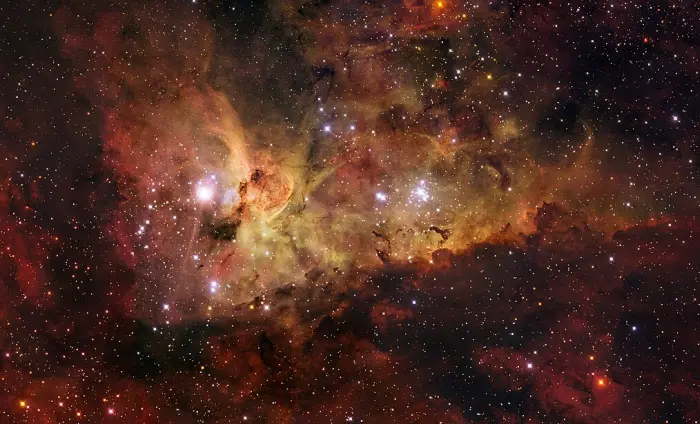
The Carina Nebula is a large bright nebula that surrounds several clusters of stars. It contains two of the most massive and luminous stars in our Milky Way galaxy, Eta Carinae and HD 93129A. Located 7500 light years away, the nebula itself spans some 260 light years across, about 7 times the size of the Orion Nebula, and is shown in all its glory in this mosaic. It is based on images collected with the 1.5-m Danish telescope at ESO’s La Silla Observatory. Image credit: ESO/IDA/Danish 1.5 m/R.Gendler, J-E. Ovaldsen, C. Thöne, and C. Feron (CC BY 4.0 DEED)
Surroundings
Eta Carinae lies within the Carina Nebula, a giant stellar nursery located in the Carina-Sagittarius Arm of the Milky Way galaxy. The star system is a member of the young open cluster Trumpler 16, and it is enclosed by the Homunculus Nebula, a small emission and reflection nebula formed in the 19th century during the Great Eruption.
Homunculus Nebula
The Homunculus Nebula is the bright bipolar emission and reflection nebula that immediately surrounds the Eta Carinae star system. The name Homunculus means “little man” in Latin. The nebula is believed to have formed during the central star’s enormous outburst in the mid-19th century, which made Eta Carinae the second brightest star in the sky. The bipolar lobes of the Homunculus Nebula have the longest radius of 22,000 astronomical units (AU).
The Homunculus is a miniature H II region, where hydrogen gas is shocked into an ionized state. The nebula absorbs a significant portion of Eta Carinae’s light and re-emits it as infrared. The Homunculus is the brightest source in the sky at mid-infrared wavelengths.
The Homunculus Nebula contains the smaller Little Homunculus which, in turn, contains the Baby Homunculus. The Baby Homunculus is composed of a shell of shocked material from the central star system’s stellar winds. It was discovered in 2014 by the Atacama Large Millimeter/submillimeter Array (ALMA), an astronomical interferometer that combines 66 radio telescopes in the Atacama Desert in northern Chile.
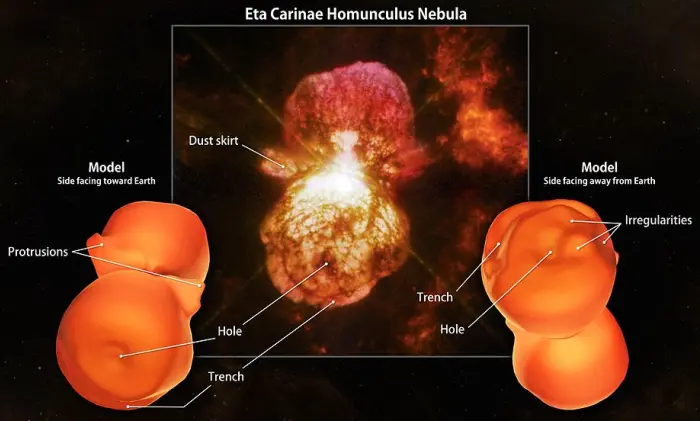
The Homunculus Nebula surrounds Eta Carinae, a pair of famously unstable massive stars in a binary system embedded in the extensive Carina Nebula about 7,500 light-years distant. Between 1838 and 1845, Eta Carinae underwent the Great Eruption becoming the second brightest star in planet Earth’s night sky and ejecting the Homunculus Nebula. The 3D model of the still expanding Homunculus was created by exploring the nebula with the European Southern Observatory’s VLT/X-Shooter. That instrument is capable of mapping the velocity of molecular hydrogen gas through the nebula’s dust at a fine resolution. It reveals trenches, divots and protrusions, even in the dust-obscured regions that face away from Earth. Eta Carinae itself still undergoes dramatic outbursts and is a candidate to end its life in a spectacular supernova in the next few million years. Image credit: NASA/GSFC/SVS; Inset: NASA, ESA, Hubble SM4 ERO Team; Science: W. Steffen (UNAM), M. Teodoro, T.I. Madura, J.H. Groh, T.R. Gull, A. Mehner, M.F. Corcoran, A. Damineli, K. Hamaguchi
The Little Homunculus is believed to have formed during the 1890 eruption, while the Baby Homunculus is composed of material ejected by Eta Carinae in 1941.
The Homunculus Nebula was named by the Argentinian astrophysicist Enrique Gaviola of the Córdoba University in 1950. In a paper published in The Astrophysical Journal, Gaviola wrote, “The complex structure of the brighter part of the star’s nebulosity – within 6’’ of the center – was observed at Bosque Alegre with the 61-inch reflector the first time the star was put on the slit of the new spectrograph in the early morning of January 9, 1944. Under a power of 1,200 diameters and star images not larger than 1’’ a shape resembling a ‘homunculus,’ with its head pointing northwest, legs opposite and arms folded over a fat body, could clearly be seen.”
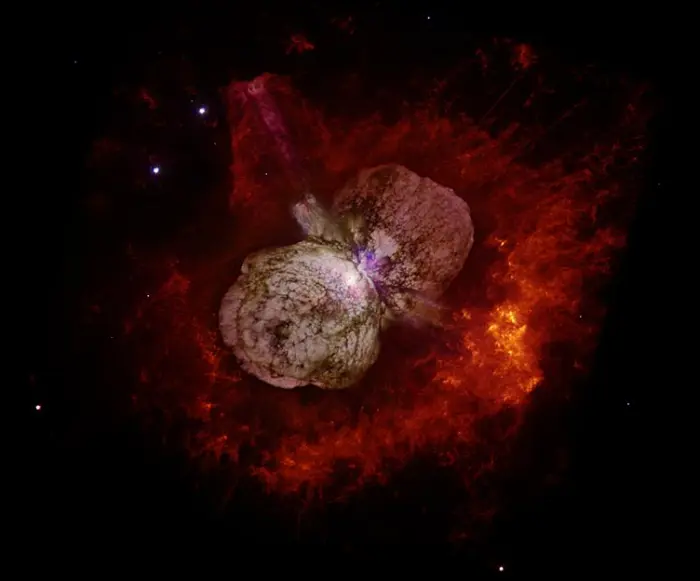
Eta Carinae and the Homunculus Nebula captured by the Hubble Space Telescope, image credit: Nathan Smith (University of California, Berkeley), and NASA
Trumpler 16
Trumpler 16 (Collinder 234) is a massive, young open cluster that contains some of the Milky Way’s most luminous stars. The cluster lies approximately 9,270 light-years away and shines at magnitude 5.0. It is one of the main open clusters of the Carina OB1 stellar association, the largest stellar association within the larger Carina Nebula.
Eta Carinae is the most massive and luminous member of Trumpler 16. It is the only member of the cluster that is visible to the unaided eye. Both Trumpler 16 and its neighbour Trumpler 14 may be spotted without binoculars on a clear, dark night.
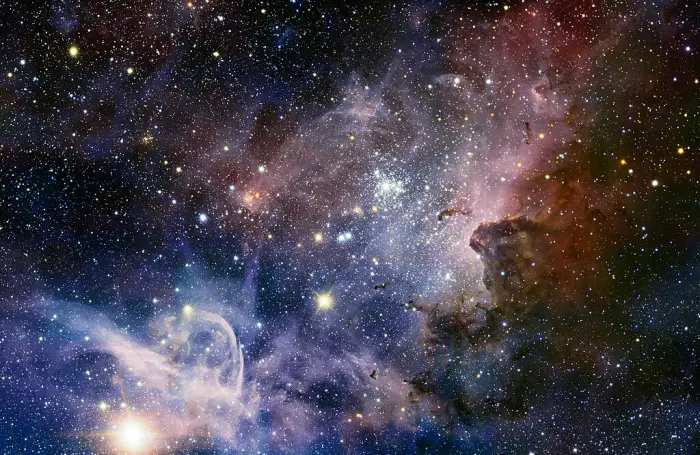
This broad panorama of the Carina Nebula, a region of massive star formation in the southern skies, was taken in infrared light using the HAWK-I camera on ESO’s Very Large Telescope. Many previously hidden features, scattered across a spectacular celestial landscape of gas, dust and young stars, have emerged. Eta Carinae and Trumpler 16 appear in the bottom left corner and Trumpler 14 appears in the centre of the image. Credit: ESO/T. Preibisch (CC BY 4.0 DEED)
Trumpler 16 is also home to WR 25, a massive binary star system composed of a Wolf-Rayet star with 98 times the Sun’s mass and a luminosity of 2,400,000 Suns, and a hot blue O-type companion. The stars have an orbital period of 207.85 days. WR 25 emits most of its radiation in the ultraviolet band and is invisible to the unaided eye because it is heavily obscured by dust. Without the heavy extinction, the behemoth would shine at magnitude 4.49 from a distance of 6,425 light-years.
Other members of Trumpler 16 include the massive blue binary star HD 93250, which has an energy output of a million Suns, and the binary star system V560 Carinae (HD 93205), whose primary component shines with 1,160,000 solar luminosities.
Carina Nebula
The Carina Nebula is a vast star-forming region visible to the unaided eye from the southern hemisphere. It has an apparent magnitude of +1.0. The giant complex of bright and dark nebulae lies approximately 8,500 light-years from the Sun and has an apparent size of 120 by 120 arcminutes. This corresponds to a physical radius of 230 light-years. The nebula is also known as the Eta Carinae Nebula.
The star-forming region contains several objects, including the Homunculus Nebula surrounding Eta Carinae, the dark cloud known as the Keyhole Nebula, the pillar of gas and dust called the Mystic Mountain, a Bok globule nicknamed the Defiant Finger (or the Finger of God), and the open clusters Trumpler 14, Trumpler 15, and Trumpler 16.
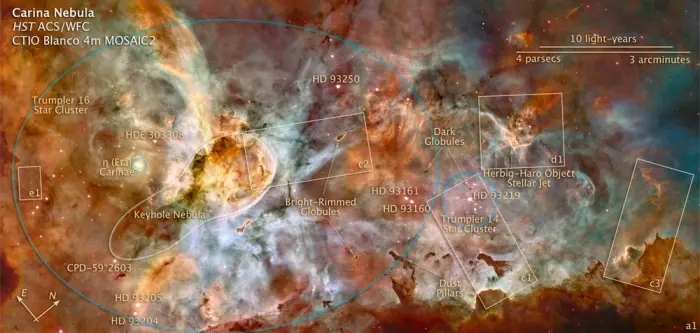
Hubble’s view of the Carina Nebula shows star birth in a new level of detail. The fantasy-like landscape of the nebula is sculpted by the action of outflowing winds and scorching ultraviolet radiation from the monster stars that inhabit this inferno. In the process, these stars are shredding the surrounding material that is the last vestige of the giant cloud from which the stars were born. The immense nebula contains at least a dozen brilliant stars that are roughly estimated to be at least 50 to 100 times the mass of our Sun. The most unique and opulent inhabitant is the star Eta Carinae, at far left. Eta Carinae is in the final stages of its brief and eruptive lifespan, as evidenced by two billowing lobes of gas and dust that presage its upcoming end as a titanic supernova. The fireworks in the Carina region started three million years ago when the nebula’s first generation of newborn stars condensed and ignited in the middle of a huge cloud of cold molecular hydrogen. Radiation from these stars carved out an expanding bubble of hot gas. The island-like clumps of dark clouds scattered across the nebula are nodules of dust and gas that are resisting being eaten away by photoionization.
The hurricane blast of stellar winds and blistering ultraviolet radiation within the cavity is now compressing the surrounding walls of cold hydrogen. This is triggering a second stage of new star formation. This image is a mosaic of the Carina Nebula assembled from 48 frames taken with Hubble Space Telescope’s Advanced Camera for Surveys. The Hubble images were taken in the light of neutral hydrogen. Color information was added with data taken at the Cerro Tololo Inter-American Observatory in Chile. Red corresponds to sulfur, green to hydrogen, and blue to oxygen emission. Image credit: NASA, ESA, N. Smith (University of California, Berkeley), and The Hubble Heritage Team (STScI/AURA); credit for CTIO image: N. Smith (University of California, Berkeley) and NOAO/AURA/NSF
The Carina Nebula hosts some of the most massive and luminous stars known in our galaxy. Besides Eta Carinae, these include the eclipsing binary system WR 22, the binary star WR 25, the triple star system HD 93129, and the binary star system HD 93250.
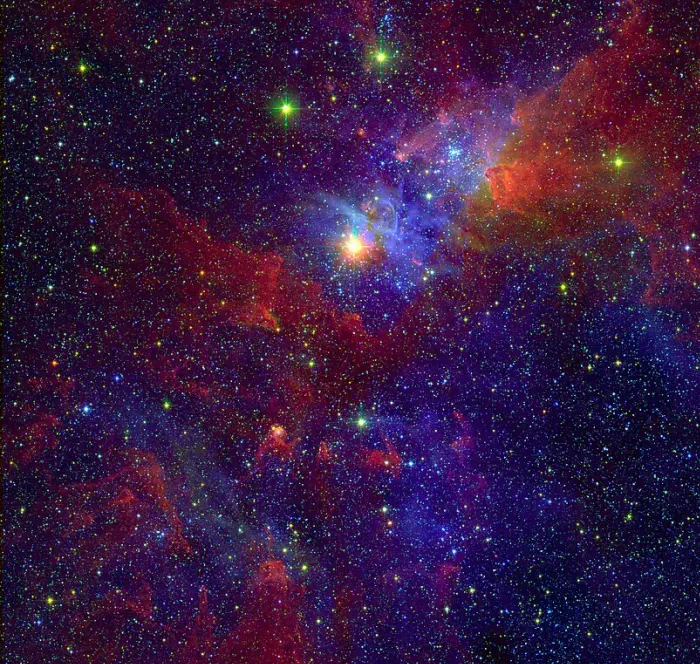
Eta Carinae is one of the most massive and brightest stars in the Milky Way. Compared to our own Sun, it is about 100 times as massive and a million times as bright. This famed variable hypergiant star (upper center) is surrounded by the Carina Nebula. In this composite image spanning the visible and infrared parts of the spectrum, areas that appear blue are not obscured by dust, while areas that appear red are hidden behind dark clouds of dust in visible light. A study combining X-ray and infrared observations has revealed a new population of massive stars lurking in regions of the nebula that are highly obscured by dust. Adding these new massive stars to the known massive stars suggests that the Carina Nebula will produce twice as many supernovae as previously supposed. Visible light in the blue part of the spectrum from the Digital Sky Survey is represented as blue, near infrared light with a wavelength of 2.2 microns from the Two Micron All Sky Survey (2MASS) is green, and infrared observations from the Infrared Array Camera on NASA’s Spitzer Space telescope at 3.6 microns is red. Image credit: NASA/JPL-Caltech/M. Povich (Penn State Univ.)
Eta Carinae lies at the same distance as the Carina Nebula and the star’s spectrum has been detected as reflected off the larger nebula’s clouds. The ionizing radiation of Eta Carinae has dramatically altered the appearance of the nebula in the past 150 years, since it was observed and described by the British astronomer John Herschel. Before the Great Eruption, the massive star system contributed up to 20% of the ionising flux for the entire Carina Nebula. Now the star’s radiation is mostly blocked by the intervening dust and gas.
The Carina Nebula was one of the first targets of the James Webb Space Telescope (JWST). Images of the nebula were released on July 12, 2022.
Facts
Eta Carinae was first recorded by English astronomer Edmond Halley in 1677. His catalogue Catalogus Stellarum Australium was published in 1679. The star was catalogued as Sequens (as in “following” relative to another star) with an approximate apparent magnitude of 4 (corresponding to magnitude 3.3 on the modern scale).
Halley placed Eta Carinae in the constellation Robur Carolinum (Charles’ Oak), which he created in 1679. The constellation represented the Royal Oak where Charles II, King of Scotland, hid from the troops of Oliver Cromwell after the Battle of Worcester in 1651. Robur Carolinum fell into disuse after 50 years.
Eta Carinae may have been recorded by Dutch navigator Pieter Keyser around 1595-1596. Keyser was a celestial cartographer who travelled to the southern hemisphere and charted several southern constellations. He described a 4th magnitude star at the position of Eta Carinae during his travels, which later appeared on the celestial globes of the Dutch-Flemish astronomer Petrus Plancius and cartographer Jocodus Hondius. The star recorded by Keyser appeared in German uranographer Johann Bayer’s Uranometria of 1603.
Brazilian astronomer Augusto Damineli was the first to propose that Eta Carinae was in fact a binary system in 1996. The binary nature of the star system was confirmed in 2005, when the hot companion was detected by the Far Ultraviolet Spectroscopic Explorer (FUSE) satellite.
Eta Carinae is the brightest source of emission at mid-infrared wavelengths in the night sky.
Observations in the far infrared band have allowed scientists to estimate a total mass of 20 solar masses or more for the surrounding Homunculus Nebula. When the dust clears in a few thousand years, Eta Carinae may finally be revealed.
Observations at X-ray wavelengths have revealed several X-ray and gamma ray sources within 1 light-month of Eta Carinae. The observations were made with the Einstein Observatory (NASA’s first X-ray space telescope), the ROSAT X-ray telescope, the Advanced Satellite for Cosmology and Astrophysics (ASCA), and the Chandra X-ray Observatory. The sources correspond to the main shock front from the Great Eruption.
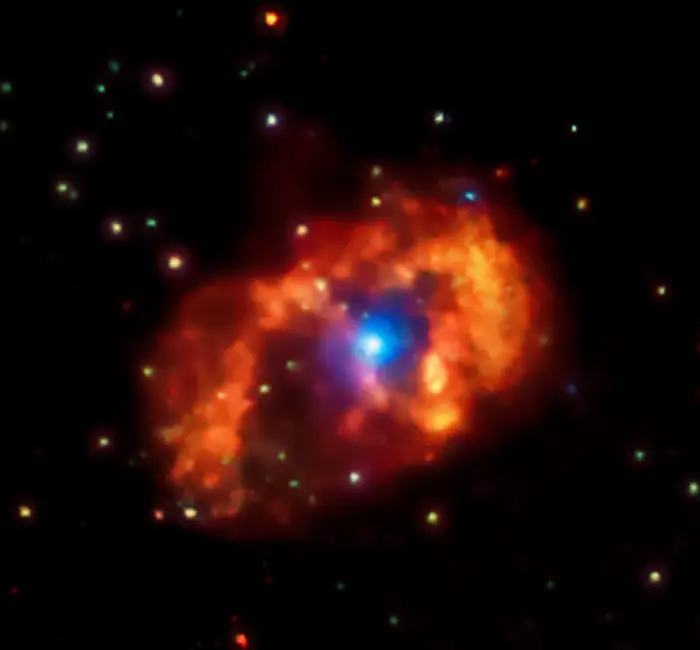
As one of the first objects observed by NASA’s Chandra X-ray Observatory after its launch, the Eta Carinae double star system continues to reveal new clues about its nature through the X-rays it generates. Today, astronomers are trying to learn more about the two stars in the Eta Carinae system and how they interact with each other. The heavier of the two stars is quickly losing mass through wind streaming away from its surface at over a million miles per hour. While not the giant purge of the Great Eruption, this star is still losing mass at a very high rate that will add up to the Sun’s mass in about a millennium. Though smaller than its partner, the companion star in Eta Carinae is also massive, weighing in at about 30 times the mass of the Sun. It is losing matter at a rate that is about a hundred times lower than its partner, but still a prodigious weight loss compared to most other stars. The companion star beats the bigger star in wind speed, with its wind clocking in almost ten times faster. When these two speedy and powerful winds collide, they form a bow shock that then heats the gas between the stars. The temperature of the gas reaches about ten million degrees, producing X-rays that Chandra detects. Image credit: ASA/CXC/GSFC/K.Hamaguchi, et al.
The radiant of the Eta Carinids meteor show appears near Eta Carinae. The weak meteor shower lasts from January 14 to 27 each year. It peaks on January 21 with two to three meteors visible per hour at its maximum. The meteor shower was discovered by C. S. Nilsson of the Adelaide Observatory in Australia in 1961.
The distance of Eta Carinae cannot be determined using parallax because the star is surrounded by a thick nebula. Instead, astronomers have used the parallaxes of other stars in the cluster Trumpler 16 to derive the widely accepted value of around 2,330 parsecs (7,600 light-years).
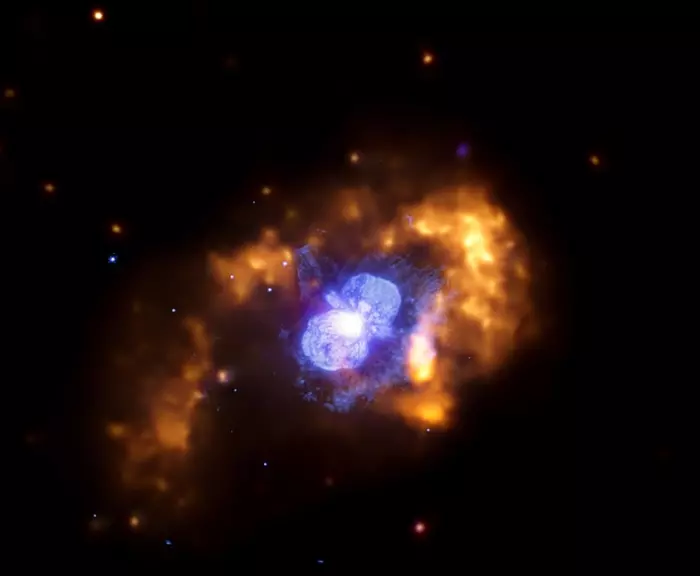
This composite image of Eta Carinae from NASA’s Chandra X-ray Observatory and Hubble Space Telescope shows the remnants of a massive eruption from the star during the 1840s. The X-ray data (yellow) show where material from that explosion has collided with nearby gas and dust. The optical data (blue) reveals material ejected from the star has formed a bipolar structure. Chandra detects a faint X-ray reflection off the inner optical nebula due to the collision of stellar winds between Eta Carinae and a suspected companion star. Image credit: Smithsonian Institution; X-ray: NASA/CXC/GSFC/M.Corcoran et al.; Optical: NASA/STScI
Name
Eta Carinae does not have a proper name. It was historically known as Foramen and Tseen She, but neither name has been formally approved by the International Astronomical Union (IAU).
The star is commonly known by its Bayer designation, Eta Carinae. It was given this designation by the French astronomer Nicolas-Louis de Lacaille in 1751. Lacaille studied the southern sky from the Cape of Good Hope in South Africa from 1750 to 1754 and created 14 of the modern 88 constellations.
The star was once known as Eta Roboris Caroli, Eta Navis or Eta Argus. It was part of the constellation Argo Navis, once the largest constellation in the sky. Argo Navis was divided into three smaller constellations – Carina, Puppis, and Vela – by the French astronomer Nicolas-Louis de Lacaille in the 18th century.
Lacaille assigned Greek letter designations to the stars of Argo Navis. The stars were given a single set of Bayer designations, which are still in use. Eta fell within the Keel of Argo Navis, represented by the constellation Carina. Lacaille recorded it as a second-magnitude star.
The star became widely known as Eta Carinae (and not Eta Argus) after the publication of American astronomer Benjamin Apthorp Gould’s Uranometria Argentina in 1879. Gould, who is best known for establishing The Astrophysical Journal and defining constellation boundaries by right ascension and declination, referred to the stars of Argo Navis by the three daughter constellations, Carina, Puppis, and Vela.
Eta Carinae did not have a traditional Chinese name. It lies in the far southern sky and was not part of the Twenty-Eight Mansions that constituted the traditional Chinese constellation system. However, it was included among the 23 Southern Asterisms toward the end of the Ming Dynasty in the 17th century. It formed an asterism known as Sea and Mountain (海山) with s Carinae, Lambda Centauri, and Lambda Muscae. It was known as 海山二 (Hǎi Shān èr), the Second Star of Sea and Mountain
The star also has the Chinese names Foramen and Tseen She (from the Mandarin phrase meaning “heaven’s altar”).
Location
Eta Carinae lies in the region of the three diamond-shaped asterisms that dominate the far southern sky, the Southern Cross, the False Cross, and the Diamond Cross. The Diamond Cross, the least prominent of the three, is the nearest to the star. A line extended from Miaplacidus through the midpoint of the imaginary line connecting Upsilon and Theta Carinae leads to Eta Carinae.
Alternatively, Eta Carinae and the Carina Nebula can be found along the imaginary line extended from Rigil Kentaurus (Alpha Centauri), the third brightest star in the sky, through Acrux (Alpha Crucis), the star at the base of the Southern Cross.
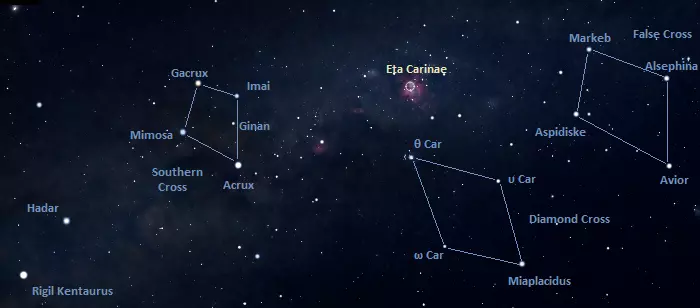
The location of Eta Carinae, image: Stellarium
Eta Carinae is visible to the unaided eye from areas without too much light pollution. It stands out as the brightest star in the Carina Nebula. The nebula itself appears bright and large and is easily seen without binoculars.
The two lobes of the Homunculus Nebula can be spotted in telescopes at high magnification.
At declination -59°41’, Eta Carinae never rises for observers north of the latitude 30° N. It cannot be seen from Europe and most of North America. The star is circumpolar for observers in the southern hemisphere living south of the latitude 30° S and can be seen throughout the year.
Constellation
Eta Carinae is located in the southern constellation Carina. Representing the Keel of Argo Navis (the Ship Argo), Carina was once part of the Greek constellation Argo Navis, which represented the ship on which Jason and the Argonauts sailed to Colchis to retrieve the Golden Fleece. Stretching across an area of 494 square degrees, Carina is the 34th largest constellation in the sky.
Carina is one of the brighter southern constellations. It contains six stars brighter than magnitude 3.0. It is home to the bright giant Canopus, the second brightest star in the sky (after Sirius), and hosts two other navigational stars, the giants Miaplacidus (Beta Carinae) and Avior (Epsilon Carinae). Some of the constellation’s bright stars are part of two conspicuous southern asterisms, the False Cross and the Diamond Cross.
Other notable stars in Carina include the white supergiant Aspidiske (Iota Carinae), the hot blue star Theta Carinae, the binary star Upsilon Carinae, the blue giant Omega Carinae, the Cepheid variable I Carinae, the variable K-type bright giant q Carinae, the luminous blue variable AG Carinae, and the Mira variables S Carinae and R Carinae.
The best-known deep sky object in Carina is the Carina Nebula, a vast stellar nursery approximately 8,500 light-years away, which contains the Homunculus Nebula and Eta Carinae.
Other bright deep sky objects in the constellation include the Southern Pleiades (the Theta Carinae Cluster, IC 2602), the open clusters NGC 2516 (the Southern Beehive), NGC 3532 (the Pincushion Cluster), the Gem Cluster (NGC 3293) and NGC 3114, and the globular cluster NGC 2808. The constellation is also home to the Statue of Liberty Nebula (NGC 3576) and the Bullet Cluster, a pair of colliding clusters of galaxies located approximately 3.7 billion light-years away.
The best time of the year to observe Eta Carinae and other stars and deep sky objects in Carina is during the month of March. The entire constellation is visible from locations south of the latitude 20° N.
The 10 brightest stars in Carina are Canopus (Alpha Car, mag. -0.74), Miaplacidus (Beta Car, mag. 1.69), Avior (Epsilon Car, mag. 1.86), Aspidiske (Iota Car, mag. 2.21), Theta Carinae (mag. 2.76), Upsilon Carinae (2.97), Omega Carinae (mag. 3.29), PP Carinae (p Car, mag. 3.22 – 3.55), V337 Carinae (q Car, mag. 3.36 – 3.44), and V357 Carinae (a Car, mag. 3.41 – 3.44).
Eta Carinae
| Spectral class | LBV + O or WR |
| Variable type | Luminous blue variable (S Doradus variable) |
| U-B colour index | -0.45 |
| B-V colour index | +0.61 |
| Apparent magnitude (V) | -1.0 – 7.6 |
| Apparent magnitude (U) | 6.37 |
| Apparent magnitude (B) | 6.82 |
| Apparent magnitude (R) | 4.90 |
| Apparent magnitude (J) | 3.39 |
| Apparent magnitude (H) | 2.51 |
| Apparent magnitude (K) | 0.94 |
| Absolute magnitude | −8.6 (2012) |
| Distance | 7,500 light-years (2,300 parsecs) |
| Radial velocity | −125.0 km/s |
| Proper motion | RA: -17.6 mas/yr |
| Dec.: 1.0 mas/yr | |
| Constellation | Carina |
| Right ascension | 10h 45m 03.5377808928s |
| Declination | −59° 41′ 04.051599720″ |
| Names and designations | Eta Carinae, Eta Car, η Car, Foramen, Tseen She, 231 G Carinae, HD 93308, HR 4210, SAO 238429, CD−59°2620, NOVA Car 1843, PPM 339408, CPD-59 2620, JP11 1994, GC 14799, GCRV 6692, GCRV 6693, IRAS 10431-5925, 2MASS J10450360-5941040, ALS 1868, LS 1868, AAVSO 1041–59, Trumpler 16 183, Hen 3-481, WRAY 15-640, TYC 8626-2809-1, Gaia DR2 5350358580171706624, Gaia DR3 5350358584482202880, WDS J10451-5941 |
Eta Carinae A
| Mass | ~100 M☉ |
| Luminosity | 4.6 million L☉ (2.96 million – 4.1 million L☉) |
| Radius | ~240 R☉ (60 – 881 R☉) |
| Temperature | 9,400–35,200 K |
| Age | <3 million years |
Eta Carinae B
| Mass | 30–80 M☉ |
| Luminosity | <1 million L☉ |
| Radius | 14.3–23.6 R☉ |
| Temperature | 37,200 K |
| Age | <3 million years |